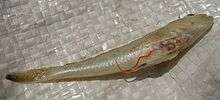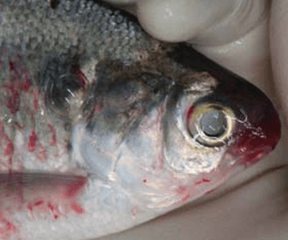Eustrongylidosis
Eustrongylidosis is a parasitic disease that mainly affects wading birds worldwide; however, the parasite's complex, indirect life cycle involves other species such as aquatic worms and fish. Moreover, this disease is zoonotic which means the parasite can transmit disease from animals to humans. Eustrongylidosis is named after the causative agent Eustrongylides and typically occurs in eutrophicated waters where concentrations of nutrients and minerals are high enough to provide ideal conditions for the parasite to thrive and persist. Because eutrophication has become a common issue due to agricultural runoff and urban development, cases of Eustrongylidosis are becoming prevalent and hard to control. Eustrongylidosis can be diagnosed before or after death by observing behavior, clinical signs and performing fecal flotations and necropsies. Methods to control Eustrongylidosis include preventing eutrophication and providing hosts with uninfected food sources in aquaculture farms. Parasites are known to be indicators of environmental health and stability and should therefore be studied further to better understand the parasite's life cycle and how it affects predator-prey interactions and improve conservation efforts.
Cause
Eustrongylidosis is caused by several species of roundworms. The nematodes are red, large, and easily noticeable and are characterized by the absence of a posterior sucker.[1] These roundworms cause a high mortality rate in nesting egrets and other wading birds, including other coastal populations.[2] The parasite was first detected in fish. The parasite is then transferred from the fish to the waterfowl when the bird is eating the fish. After consumption, the parasite perforates through the stomach lining often resulting in the death of the host.[3]
Life cycle
Eustrongylidosis is caused by three species of Eustrongylides: Eustrongylides ignotus, Eustrongylides tubifex, and Eustrongylides excisus.[4] Eustrongylides is a macroscopic roundworm or nematode that reproduces sexually year-round. The parasite has a complex life cycle that involves two intermediate hosts, a paratenic host, and a definitive host. Therefore, the life cycle is indirect because the parasite has to infect other species to reach its final host and become sexually mature and reproduce. Intermediate hosts and definitive hosts provide the parasite transport to other hosts and a place to develop whereas paratenic hosts only provide transport to other hosts. The cycle begins when the wading bird excretes feces in or nearby a water body.[4] It is in the feces where Eustrongylides eggs are shed. Once they reach the water an oligochaete, or aquatic worm, feeds on the eggs and becomes the first intermediate host. Within the oligochaete the parasite eggs hatch and develop into second and third stage larvae. When a fish feeds on the infected oligochaete it becomes the second intermediate host and the parasite develops into a fourth stage larvae. Finally, when a wading bird feeds on the infected fish it becomes the definitive or final host and Eustrongylides becomes a sexually mature. The parasite becomes an adult within 3 to 5 hours post infection and sheds eggs within 14 to 23 days post infection.[3] The cycle repeats itself when the parasite becomes sexually mature and sheds eggs through the feces of the bird to the external environment. If a larger fish, amphibian, or reptile feed on the infected fish before the wading bird does, they become paratenic hosts until fed on by the definitive host.
Species affected
Eustrongylides has been found in a variety of wildlife species including freshwater fishes.[5] Eustrongylides sp. has been observed in perch (Perca fluviatilis), sheat fish (Silurus glanis), pike (Esox lucius), pikeperch (Sander lucioperca), and sun perch (Lepomis eupomotis gibbosus).[5] Eustrongylides sp. has also been observed in wading birds (Ciconiiformes) including great blue herons (Ardea herodias), great egrets (Casmerodius albus), and snowy egrets (Egretta thula).[6]
Distribution
Eustrongylides sp. has been reported throughout most of the world. Within the United States, E. tubifex and E. ignotus have been observed within wildlife.[4] This disease can be found in rookeries, especially in areas consisting of dense bird populations.[4] Eustrongylides species are also found in nesting habitats of birds including areas with a low tree understory.[4]
Clinical Signs

Eustrongylides has evolved to infect the outside surface of the ventriculus of birds or the stomach in fish. This is due to the bird's response to parasitic infections, which involves regurgitating food to remove the parasite from their bodies. However, by inhabiting the outside of the stomach, the bird cannot get rid of the parasite and continually regurgitates food until it becomes emaciated.[3] Furthermore, the presence of the parasite in the ventriculus causes secondary infections such as bacterial peritonitis, the inflammation of the abdominal cavity walls, and sepsis, the infiltration of bacteria in the blood, when the parasite penetrates the stomach.[4] Young birds less than a week old of age are more susceptible to Eustrongylidosis than older birds for several reasons.[3] First, the immune system is still developing and weak. Second, sibling competition for food is common in young birds. Finally, their growth rate becomes suppressed. Therefore, they tend to die before the parasite becomes sexually mature and sheds eggs. Unlike young birds, older birds develop a chronic Eustrongylidosis because of their stronger immune systems. Similar to young birds, old birds have lesions in their ventriculus and develop secondary infections. A common behavior in both young and old birds includes regurgitation of food, which leads to lack of appetite and eventually anorexia or emaciation. In some cases, the parasite can inhabit the lung and cause respiratory problems that increase stress levels and severity of the disease.[7] In fish, the parasite affects its body condition in order to make it more susceptible to predation rather than to the disease.[8] Since the parasite depends on the intermediate host to reach the definitive host it cannot harm the fish without first luring it to its predator, the wading bird.
Diagnosis
Diagnosis in a live specimen is possible in the field by palpating the abdomen. As with birds, prominence of the keel could be a determinant in diagnosis, but natural history of the species needs to be understood to avoid potential misdiagnoses. However, the best form of diagnosis still remains as necropsy.[1] During the necropsy, the best diagnosis can be determined by the adult nematodes by scanning them with electron microscopy.[1] Different species of Eustrongylidosis nematodes can be differentiated by specific gender characteristics, i.e. “Male specimens of E. ignotus have a caudal sucker that lacks cuticular cleft, while a cuticular cleft is present in the caudal sucker of male specimens of E. excisus”.[1] “Eustrongylidosis can often be misdiagnosed as starvation in nestling because they are often emaciated at the time of death”.[6]
Before necropsy takes place, diagnosis by palpitation can be used to find tubular lesions. Those tubular lesions are firm, firmly attached to organs, and are felt in the subcutaneous tissue. While palpitation is practical and simple, errors can be made in nestlings’ examinations because their ribs have the potential to present as lesions. Diagnosis is also attainable by examining fecal samples, but has the high potential of false negatives. That possibility is increased in fledging feces “where severe disease may precede appearance of eggs in the feces”.[6]
Prevention and control
Because of Eustrongylides species’ complex life cycle with various host species, preventing infection and controlling outbreaks is difficult. Outbreaks of this disease are closely linked to agricultural runoff and urban development[9] Eutrophication of water bodies supports high population levels of oligochaete worms, which causes increased numbers of infected fish that eat the worms, and then the birds who eat the fish.[10]
One way to prevent Eustrongylidosis is to control oligochaete populations. Outbreaks of this parasite are closely linked to high numbers of oligochaete worms in the area's waterways. This is because the worms are essential for Eustrongylides species to reproduce. Oligochaete populations can be controlled by monitoring nutrient levels in the water, because high nutrient levels support oligochaete populations.[10] They can also be controlled by decreasing the level of oxygen in the water. Encouraging responsible farming practices in order to reduce chemical run-off will help prevent this disease from occurring.
Managers need to be diligent in catching the symptoms of the parasite before it can become an outbreak.[9] Once an outbreak of Eustrongylidosis has occurred, there is little that ecosystem managers can do to stop the spread in oligochaetes, fish and birds. Traditional anthelminthics (dewormers) are not effective in fish because they kill parasites that live inside the gastrointestinal tract, whereas Eustrongylides species live outside the stomach in the body cavity.[11] The parasites can only be removed from fish surgically, which is not feasible. In order to completely stop the Eustrongylides life cycle in fish, all fish in an affected area must be culled.[11]
Surgical removal of the parasite from wading birds is a viable option, but this would also not be feasible for a large number of birds, and it would not stop the cycle of infection.
Treatment
Treatment for Eustrongylidosis is limited in the wading bird population due to the extensive amount of perforation in the stomach lining and limited funds available for treatment. In humans who are infected with Eustrongylidosis, surgery is required to remove the parasite from the intestinal wall.[12] As surgery is not a feasible treatment option for wading fowl in the wild en masse, treatment of the infected birds (a large portion of wild populations) has not been found, nor will likely be practical.[1] There is the possibility that killing/removing the nematodes could do more harm to the host specimen than actual good.
References
- Spalding, M.; Forrester, D. (2008). "Eustrongylidosis". Parasitic Diseases of Wild Birds. pp. 289–315. doi:10.1002/9780813804620.ch16. ISBN 9780813804620.
- National Wildlife Health Center, 1999
- Spalding, M. G.; Forrester, D. J. (1993). "Pathogenesis of Eustrongylides ignotus (Nematoda: Dioctophymatoidea) in Ciconiiformes". Journal of Wildlife Diseases. 29 (2): 250–260. doi:10.7589/0090-3558-29.2.250. PMID 8487374. S2CID 11257605.
- Ciganovich, E. A., Redman, P. J., & Stenback, R. S. (2013). USGS National Wildlife Health Center Field Manual of Wildlife Diseases: Birds, 29: 223-228.
- Urdeş, L.; Hangan, M.; Diaconescu, C.; Ianiţchi, D.; Serafim, V. (2008). "Eustrongylidosis' occurence in freshwater fish from the Danubian Delta area". Scientific Papers: Animal Science and Biotechnologies. 41 (2): 182–186.
- Spalding, M. G. (1990). "Antemortem diagnosis of Eustrongylidosis in wading birds (Ciconiiformes)". Colonial Waterbirds. 13 (1): 75–77. doi:10.2307/1521425. JSTOR 1521425.
- Ballweber, L. R. (2004). "Waterfowl parasites". Seminars in Avian and Exotic Pet Medicine. 13 (4): 197–205. doi:10.1053/j.saep.2004.04.005.
- Scholz, T. (1999). "Parasites in cultured and feral fish". Veterinary Parasitology. 84 (3–4): 317–335. doi:10.1016/s0304-4017(99)00039-4. PMID 10456421.
- Coyner, D. F.; Spalding, M. G.; Forrester, D. J. (2002). "Epizootiology of Eustronglyides Ignotus in Florida: Distribution, density, and natural infections in intermediate hosts". Journal of Wildlife Diseases. 38 (3): 483–499. doi:10.7589/0090-3558-38.3.483. PMID 12238365. S2CID 7853013.
- Franson, J. C.; Cluster, T. W. (1994). "Eustronglyidosis in wading birds from colonies in California, Texas, and Rhode Island, USA". Colonial Waterbirds. 17 (2): 168–172. doi:10.2307/1521295. JSTOR 1521295.
- Yanong, R. P. E. (2006). Nematode (roundworm) infections in fish. Circular 91, Department of Fisheries and Aquatic Sciences, Florida Cooperative Extension Service, Institute of Food and Agricultural Sciences, University of Florida. https://edis.ifas.ufl.edu/fa091
- (Martin et al. 2000)
